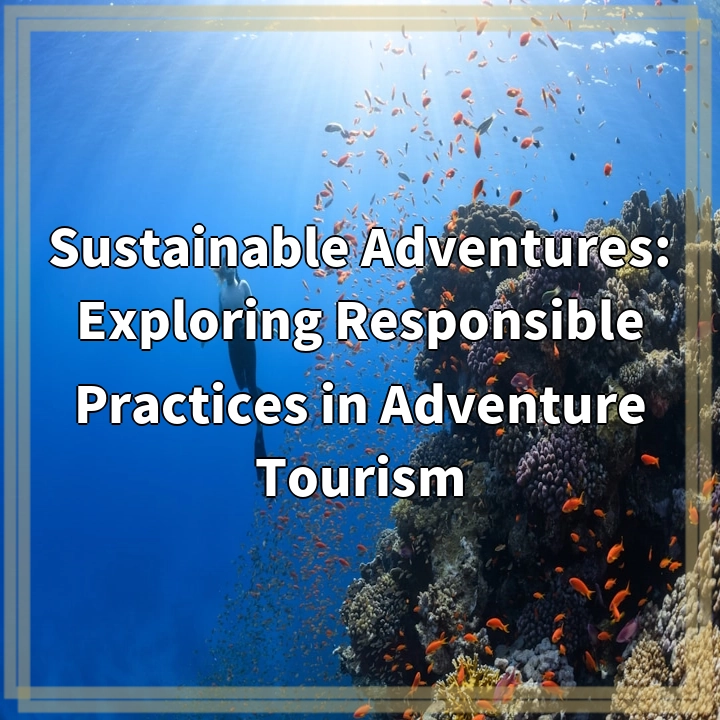
What is Sustainable Adventures?
Adventure tourism is a growing industry that combines outdoor activities with unique travel experiences. From rock climbing and hiking to wildlife safaris and scuba diving, adventure tourism offers thrill-seekers a chance to explore the wonders of our planet. However, this industry also has its drawbacks, particularly when it comes to its environmental impact.
Real-World Problems of Adventure Tourism
While adventure tourism can bring significant economic benefits to local communities and conservation efforts, it also poses significant challenges to the environment. These include:
1. Overcrowding and Degradation of Natural Areas
Popular adventure destinations often face issues of overcrowding, resulting in increased pressure on fragile ecosystems. Excessive foot traffic and improper waste disposal can lead to soil erosion, habitat degradation, and disturbance to wildlife populations.
2. Carbon Footprint and Climate Change
Adventure tourism frequently involves long-distance travel, contributing to a significant carbon footprint. Air travel, in particular, releases greenhouse gases that contribute to climate change. As tourists flock to remote locations for adventure activities, their increased carbon emissions can have a detrimental impact on the environment.
3. Wildlife Disturbance and Habitat Destruction
Certain adventure activities, such as off-road biking or unregulated wildlife encounters, can disrupt natural habitats and cause distress to animal populations. Noise pollution, destruction of nesting grounds, and alteration of feeding patterns are common issues associated with adventure tourism.
4. Insufficient Regulation and Monitoring
In some cases, adventure tourism operators may prioritize profit over sustainability. Lack of proper regulations can lead to unethical practices, such as the exploitation of local communities, inadequate safety measures, or disregard for environmental preservation.
5. Cultural Disruption and Loss of Authenticity
As adventure tourism grows in popularity, local cultures and traditions can become commodified or misrepresented for the sake of attracting tourists. This can lead to a loss of cultural identity and a decrease in the authenticity of the travel experience.
It is crucial to address these real-world problems associated with adventure tourism by promoting sustainable practices and responsible travel behaviors. In our next blog post, we will explore potential solutions and case studies of how sustainable adventures can be achieved without compromising the environment and local communities.

Solutions for Sustainable Adventures in Adventure Tourism
Addressing the environmental issues associated with adventure tourism requires the implementation of sustainable practices and responsible travel behaviors. Here are some solutions that can contribute to a more sustainable future:
1. Promote Sustainable Destination Management
Effective destination management strategies, such as limiting the number of visitors to sensitive areas, implementing waste management systems, and enforcing responsible behavior guidelines, can help mitigate the impact of overcrowding and degradation of natural areas.
2. Encourage Low-Impact Transportation
Adventure tourists can choose travel options that have a lower carbon footprint, such as using eco-friendly modes of transportation like trains or buses instead of flying. Additionally, supporting local transportation services or opting for carbon offsets can help reduce the environmental impact of travel.
3. Promote Wildlife-Friendly Practices
Adventure tourism operators should adhere to guidelines that minimize disturbance to wildlife and their habitats. This includes respecting restricted areas, maintaining distance from animals, and avoiding activities that may harm or disrupt their natural behaviors.
4. Implement Ethical Guidelines and Certification
Regulating bodies and industry associations can establish ethical guidelines for adventure tourism operators. Certifications, like eco-tourism labels, can help travelers identify companies that prioritize sustainability and responsible practices.
5. Foster Community Engagement and Empowerment
Adventure tourism should involve local communities in decision-making processes and ensure their fair participation and economic benefit. Supporting community-led initiatives, hiring local guides, and respecting local customs and traditions are vital for maintaining cultural authenticity and addressing social disruptions.
By implementing these solutions and promoting sustainable adventures, we can safeguard our natural environments, conserve biodiversity, support local communities, and foster a responsible and authentic adventure tourism industry.















